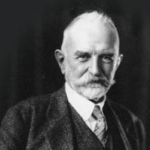Background
Herbert Blumer was born on March 7, 1900, in St. Louis, Missouri, United States. He was the son of Richard George and Margaret (Marshall) Blumer.

101 Selma Ave, Webster Groves, MO 63119, United States
Herbert Blumer attended Webster Groves High School.
Columbia, MO 65211, United States
In 1921 Herbert Blumer received a Bachelor of Arts degree from the University of Missouri. In 1922 he obtained a Master of Arts degree from this university.
5801 S Ellis Ave, Chicago, IL 60637, United States
In 1928 Herbert Blumer gained a Doctor of Philosophy degree from the University of Chicago.
Herbert Blumer
Herbert Blumer
Herbert Blumer









https://www.amazon.com/Critiques-Research-Social-Sciences-Znanieckis/dp/0878553126/ref=sr_1_1?dchild=1&keywords=Critiques+of+Research+in+the+Social+Sciences%3A+An+Appraisal+of+Thomas+and+Znaniecki%27s+The+Polish+Peasant+in+Europe+and+America+Herbert+Blumer&qid=1596095973&s=books&sr=1-1
1939

(This is a collection of articles dealing with the point o...)
This is a collection of articles dealing with the point of view of symbolic interactionism and with the topic of methodology in the discipline of sociology. It is written by the leading figure in the school of symbolic interactionism, and presents what might be regarded as the most authoritative statement of its point of view, outlining its fundamental premises and sketching their implications for sociological study. Blumer states that symbolic interactionism rests on three premises: that human beings act toward things on the basis of the meanings of things have for them; that the meaning of such things derives from the social interaction one has with one's fellows; and that these meanings are handled in, and modified through, an interpretive process.
https://www.amazon.com/Symbolic-Interactionism-Perspective-Herbert-Blumer/dp/0520056760/ref=sr_1_1?dchild=1&keywords=Symbolic+Interactionism%3A+Perspective+and+Method+Herbert+Blumer&qid=1596096054&s=books&sr=1-1
1969

(Herbert Blumer wrote continuously and voluminously, and c...)
Herbert Blumer wrote continuously and voluminously, and consequently left a vast array of unpublished work at the time of his death in 1987. This posthumously published volume testifies further to his perceptive analysis of large-scale social organizations and elegant application of symbolic interactionist principles. Blumer's focus on the processual nature of social life and on the significance of the communicative interpretation of social contexts is manifest in his theory of industrialization and social change. His theory entails three major points: industrialization must be seen in processual terms, and the industrialization process is different for different historical periods; the consequences of industrialization are a function of the interpretive nature of human action and resembles a neutral framework within which groups interpret the meaning of industrial relations, and the industrial sector must be viewed in terms of power relations; industrial societies contain inherently conflicting interests. The editors' introductory essay outlines Blumer's metatheoretical stance (symbolic interactionism) and its emphasis on the adjustive character of social life. It places Blumer's theory in the context of contemporary macro theory, including world systems theory, resource dependence theory, and modernization theory.
https://www.amazon.com/Industrialization-Agent-Social-Change-Communication-ebook/dp/B0792BM2TX/ref=sr_1_1?dchild=1&keywords=Industrialization+as+an+Agent+of+Social+Change%3A+A+Critical+Analysis+Herbert+Blumer&qid=1596096344&s=books&sr=1-1
1990
Herbert Blumer was born on March 7, 1900, in St. Louis, Missouri, United States. He was the son of Richard George and Margaret (Marshall) Blumer.
Herbert Blumer attended Webster Groves High School. In 1921 he received a Bachelor of Arts degree from the University of Missouri. In 1922 he obtained a Master of Arts degree from this university. In 1928 Blumer gained a Doctor of Philosophy degree from the University of Chicago. Blumer played football professionally there.
From 1922 to 1925 Herbert Blumer taught at the University of Missouri, teacher. From 1928 to 1952 he was a professor of sociology at the University of Chicago. Blumer was the secretary-treasurer of the American Sociological Association from 1930 to 1935. He was the editor of the American Journal of Sociology from 1941 to 1952. He later became the founding chair of the Department of Sociology at the University of California, Berkeley, serving from 1952 to 1972. In 1956 he was appointed the president of the American Sociological Association.
He was the theoretical and methodological leader of "symbolic interactions," and was identified as its foremost proponent for a half-century. His publications include works on industrial relations, research methods, mass society, collective behavior, race relations, and social movements. Among Blumer’s more influential works were his studies from the early 1930s on the effects of movies on children. In the context of blaming movies for the rebellion of the younger generation, the Payne Fund, a foundation for research on children, hired a number of prominent social scientists to study the influences of movies on children. Blumer was among the social scientists hired for the project.
He published several works, including Movies and Conduct (1933), Movies, Delinquency, and Crime (1933), Critiques of Research in the Social Sciences: An Appraisal of Thomas and Znaniecki's The Polish Peasant in Europe and America (1939), Symbolic Interactionism: Perspective and Method (1969), etc.
Herbert Blumer's pre‐eminent contribution to sociology and social psychology is his formulation of a distinctive theoretical and methodological perspective known as symbolic interactionism. Emphasizing the salience of individual and collective processes of definition in shaping action, he crafted enduringly relevant and discipline‐defining analyses of a host of subjects, including collective behavior, social movements, fashion, race relations, industrial and labor relations, social problems, morale, public opinion, social attitudes, social change, public sector social science research, and social psychology. Consistent with his pragmatist‐informed perspective, he assigned social interaction the central role in creating, maintaining, and changing social reality. In 1983 the American Sociological Association honored him with its Career of Distinguished Scholarship Award, acknowledging the importance of his codification of the fundamental theoretical and methodological tenets of the sociological perspective that he called symbolic interactionism.
(This is a collection of articles dealing with the point o...)
1969(Herbert Blumer wrote continuously and voluminously, and c...)
1990While attending the University of Chicago, Herbert Blumer was influenced academically by George Herbert Mead, W. I. Thomas, and Robert Park. He even took over Mead’s classes upon Mead’s death in the early 1930s. Blumer's theory of symbolic interactionism, which he first set forth in a 1937 article on the nature of social psychology published in Man and Society, was based in large part on Mead's "understanding of the individual as an acting entity and the importance of empirical observation as primary to methodology." "He was also influenced by Thomas's idea that each situation must be defined, and John Dewey's understanding of the interaction between humans and the natural world."
Blumer's theory of symbolic interaction was based on his idea that meaning is created and re-created through social interaction. "He built symbolic interactionism on three main principles," it was noted in the World of Sociology profile. "First, human beings respond to things based on the meanings those things hold for them. Second, those meanings are formed from the interaction of the individual with others. And, third, the individual uses an interpretive process to assess, formulate, and modify these meanings each time the person encounters them in his or her environment."
Traditional sociological methodology drastically underestimated the importance of the meaning a person places on things they encounter, Blumer believed. Blumer thought that objects have an independent empirical existence, and in order to determine the meaning of an object most relevant to human behavior, it has to be interpreted in the context of social interaction. Blumer’s ideas were contrary to those of traditionalists who believed that objects have innate meaning. Blumer asserted that meaning is assigned to an object through a person's interactive interpretative process. With interaction as the basis of the creation of meaning, Blumer derived a series of basic ideas he called "root images." These ideas depict selfinteraction as well as the interaction between human groups and societies.
"Emphasizing the action of individuals as key, Blumer asserted that social interactionism allows for the best, direct observation of human behavior and interaction because the sociologist must necessarily be involved in the exploratory study at the micro-level of an individual phenomenon," it was stated in the World of Sociology profile.
Quotations: "The fact that the human act is self-directed or built up means in no sense that the actor necessarily exercises excellence in its construction. Indeed, he may do a very poor job in constructing his act."
To many of his students and colleagues, Herbert Blumer seemed larger than life. He was a big, strong, hearty person whose booming voice could ring with laughter or quiet a multitude. His intellectual passion was intense and contagious. At the same time, he was an extremely gentleman, always respectful, always concerned for others. This combination of strength and grace set him apart. It gave a special quality to his role as an intellectual leader, colleague, and friend.
Herbert Blumer was married twice, first in 1922 to Marguerite Barnett, with whom he had one daughter, Katherine. After their divorce, he married Marcia Jackson in 1943. They had two daughters, Linda and Leslie.

